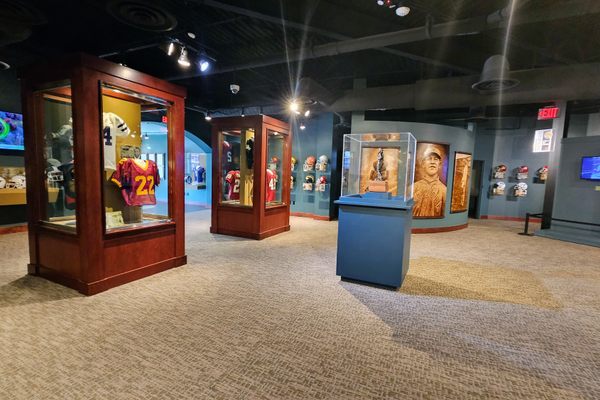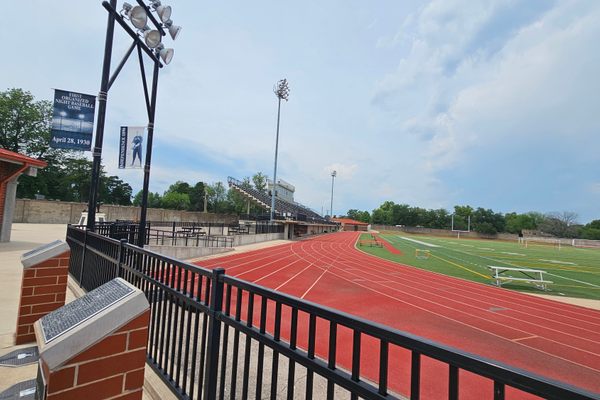AO Edited
Oval Gasholder
How did a fuel storage container become one of the most famous sights in the sporting world of cricket?
Some of the older sports stadiums around the world feature either unusual in-built features or eccentric neighborhoods that have developed around them over a century or more. In London, one of the oldest sporting locations is the Oval Cricket Ground, often called the Oval and currently branded as the Kia Oval. Looming behind the stands on the north side of the cricket ground is a seemingly out-of-place gasholder (or gasometer) commonly called the Oval Gasholder.
The history of the cricket ground and the gasholder are surprisingly intertwined. The cricket ground was established in 1845 and was initially the home of the Surrey Cricket Club. In that same year, the Phoenix Gas Light & Coke Company bought the waterworks on the site to the north of the cricket ground and converted their site into a gasworks. A total of five gasholders were built on the site between 1847 and 1874. The gasholder nearest the cricket ground, which would officially be designated Gasholder Number 1, was erected in 1853. At a height of 135 feet, the Oval Gasholder was the tallest gasholder in the world when it was constructed.
The Oval Gasholder, while notably large among the United Kingdom’s Victorian-era gasholders, looks and previously operated in a very similar way to other gasholders across the United Kingdom. It has a steel frame surrounding a collapsible cylindrical structure that holds the gas. When the gasholder is filled, the cylinder expands, but as the gas is distributed by the utility to its customers, the cylinder collapses. Initially these structures held gas created by burning coal but later transitioned to natural gas.
Over the decades, the steel frame of the Victorian-era gasholder has towered over the cricket ground’s north stands, providing an unusual industrial backdrop to the sporting events at the site. At first, the venue was used for multiple sports aside from cricket, including football (soccer) and rugby, but it eventually came to be used mainly for cricket. Most famously, starting in 1880, the Oval started hosting international matches between the Australian and England cricket teams. These matches would soon be named “the Ashes,” one of the most famous rivalries in cricket. Going forward from the 1880s, the Oval would serve as the home stadium for England’s cricket team.
Meanwhile, the Oval Gasholder continued to be used for gas storage, often decorated with banners that were visible from both the stadium and on television broadcasts. However, with improvements in gas storage in the late 20th century, gasholders like this were no longer needed. All of the gasholders at the site north of the cricket ground were decommissioned in 2014, and almost everything at the site was slated for demolition. The Oval Gasholder, on the other hand, was given Grade II listed status by English Heritage, which means that the structure will be preserved.
The former gas works will be redeveloped into housing, which is direly needed in London. This includes the construction of new apartment building inside the frame of the Oval Gasholder, and this has generated significant controversy, although similar apartment buildings have been built inside the frames of other historic gasholders. Nonetheless, the Oval Gasholder will continue to loom in the background of international cricket games for the foreseeable future.
Know Before You Go
Traveling to the Oval Gasholder (and the Oval Cricket Ground) is relatively straightforward. The Oval Underground station is located just southeast of the cricket ground, while the Vauxhall Train and Underground station is located nearby to the northwest. Many buses also travel to the area. However, parking is very limited in the area, and visitors during cricket matches are strongly encouraged to use public transport instead of driving.
While construction is ongoing at the former gasworks, the Oval Gasholder can be easily seen from the street running along the north side of the Oval Cricket Ground. People can also visit the Oval Cricket Ground during a match and also see the Oval Gasholder from the stands on the south side of the sporting venue.





















Follow us on Twitter to get the latest on the world's hidden wonders.
Like us on Facebook to get the latest on the world's hidden wonders.
Follow us on Twitter Like us on Facebook